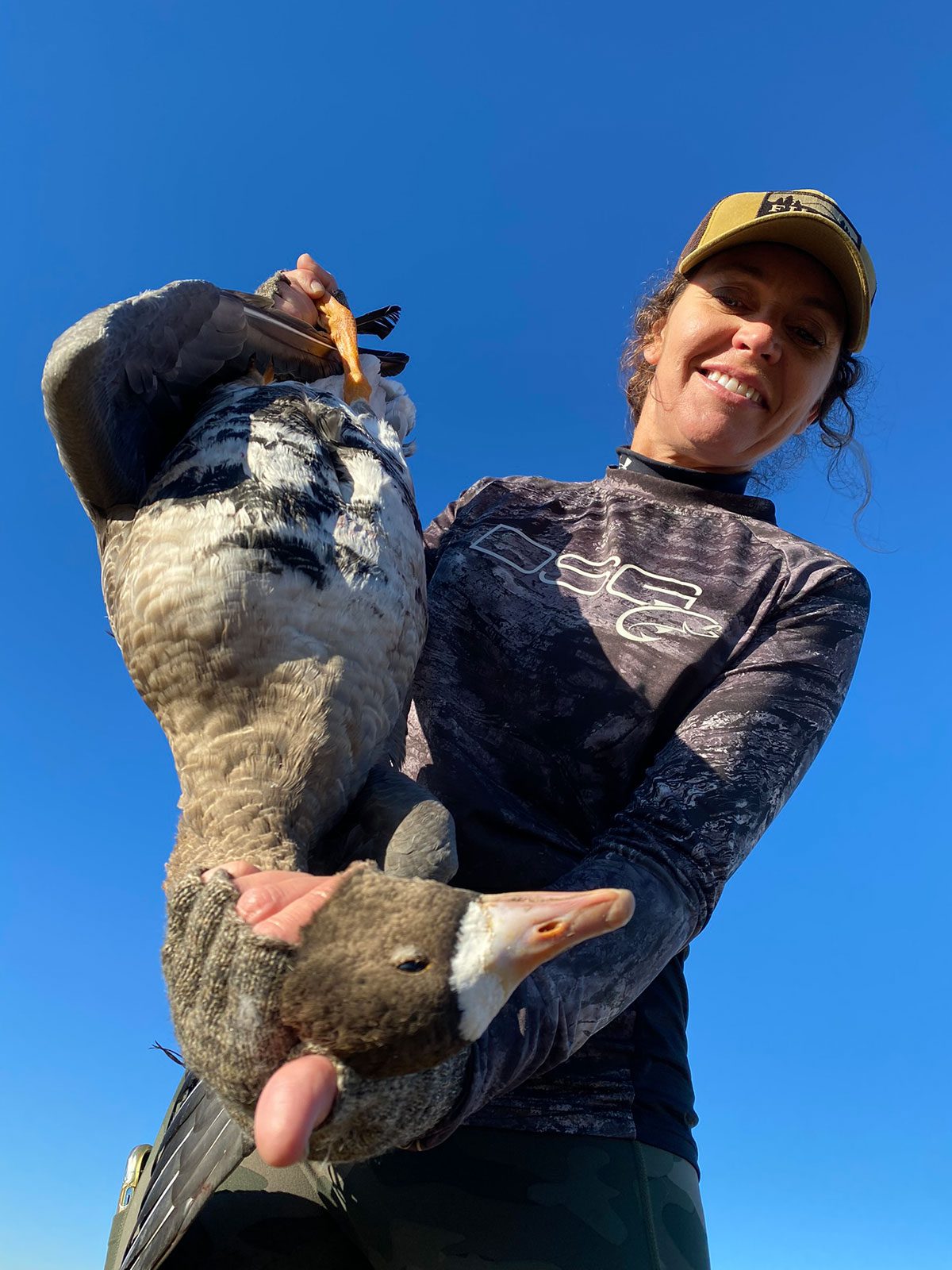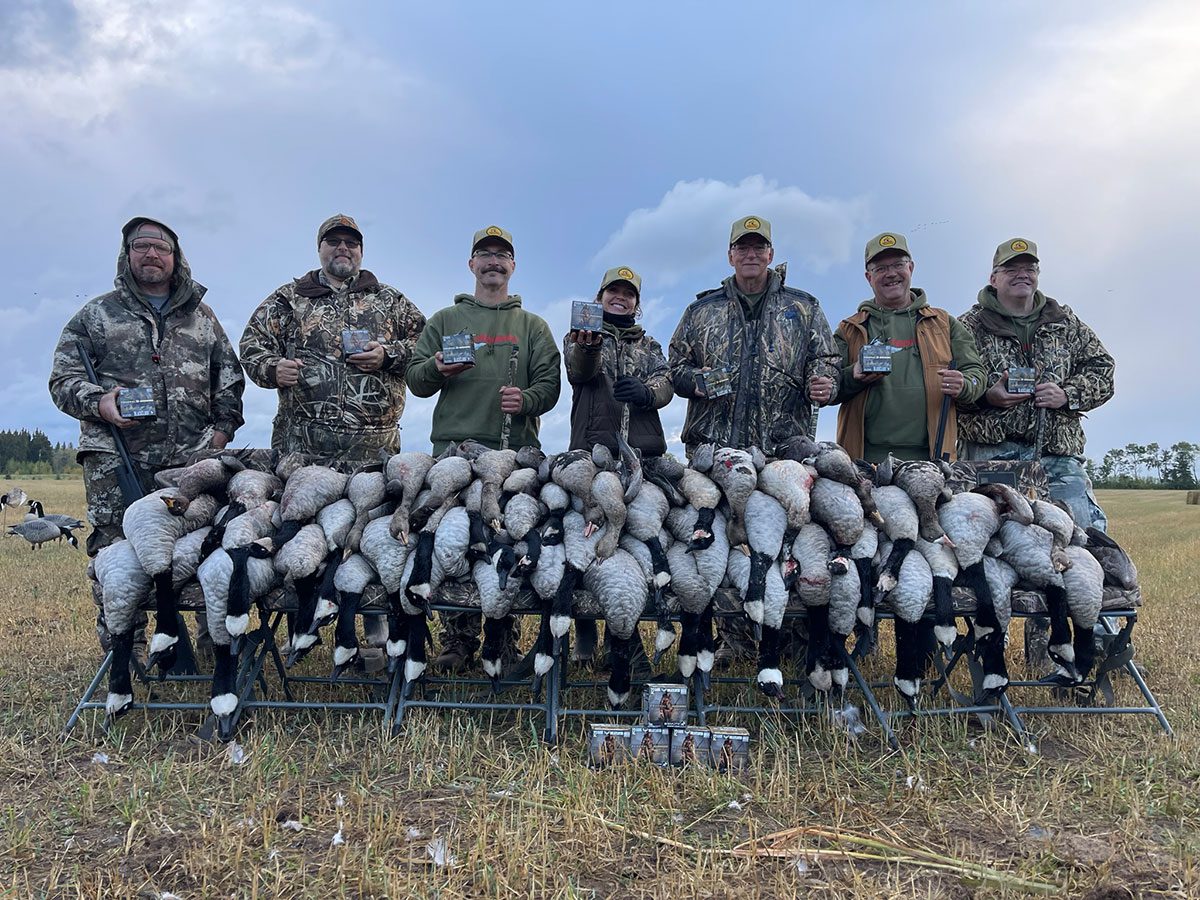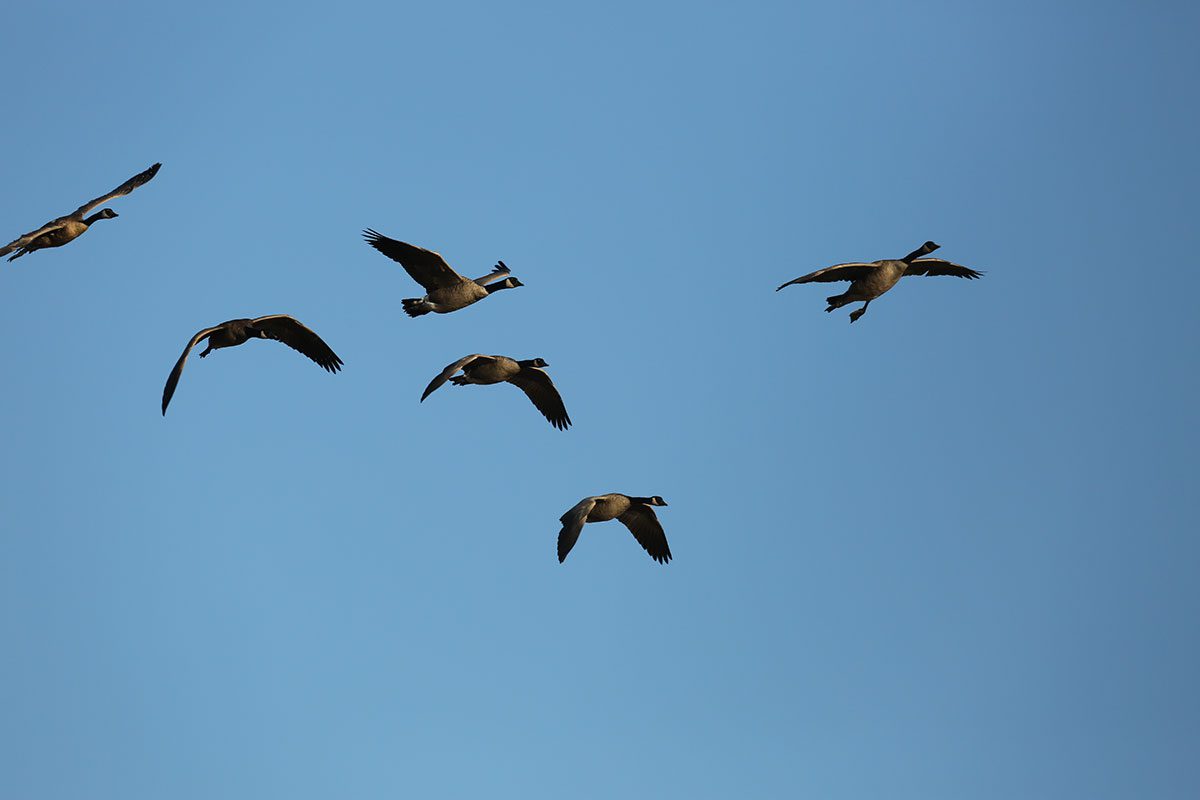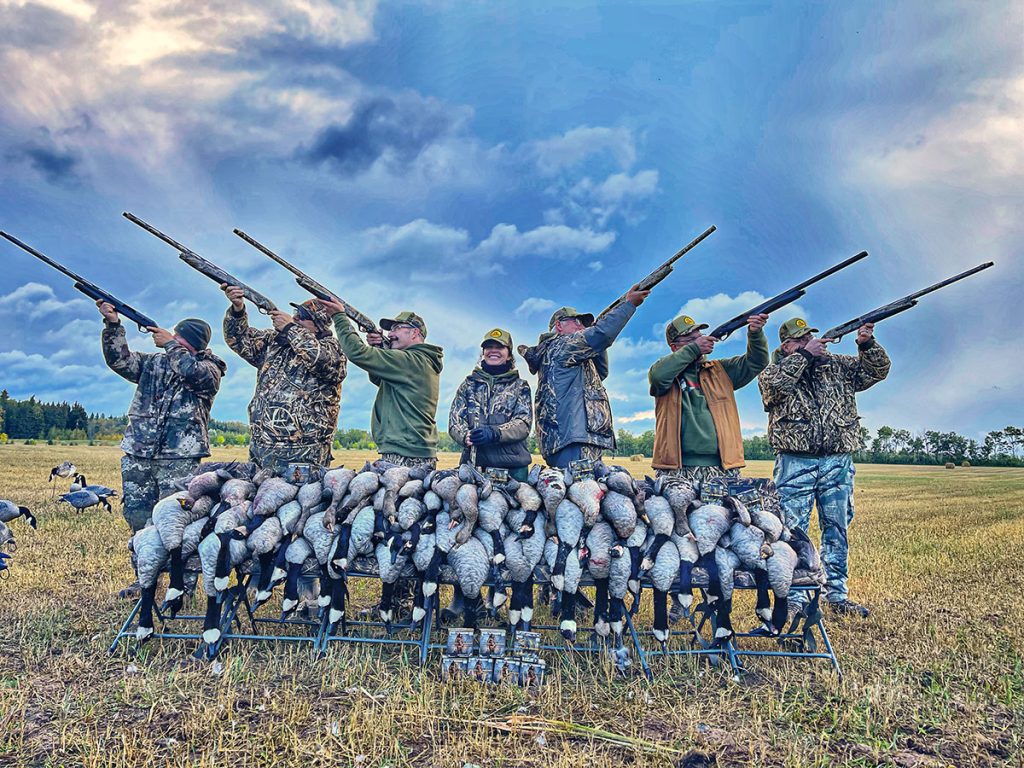Sorting out the confusion in the Shotgun Shell world
We bustled through the field like a colony of ants to set the decoys out in a steady drizzle of rain. The dark clouds looked ominous, but the anticipation of geese decoying helped us overlook the damp conditions. We were hunting in northeast Alberta with Take-Em Outfitters, with a unique crowd of people from within the ammunition industry. There have been some big corporate changes in the shotgun shell world, with Vista Outdoor now being The Kinetic Group, owning Federal Premium, Remington Ammunition, and HEVI-Shot. Companies that once guarded secrets about components and load data now share information to streamline production and ensure quality at all levels.
We had an incredible assortment of shotshells to make lots of noise and optimistically bring down a few birds. We were armed with a cornucopia of waterfowl loads. The only problem was trying to decide what to use and when. As a young hunter, I often played the shell game by emptying a particular load out of my shotgun to fill it with another. Goose loads were often exchanged for duck loads or vice versa. Today, the decision is even more challenging, with more options than ever.

The first morning out, we were targeting big honkers and specklebellies. Federal Premium Black Cloud was my obvious choice. However, some in our crew opted for the HEVI-XII with extra knockdown power and dense tungsten loads with incredible reach. We would have many opportunities to make noise with seven shooters in the crowd, and as the sun brightened the eastern sky, the drizzle started to let up.
The specks were the first to arrive and worked the decoys as if scripted. The telltale melodic voices of the arctic geese are hard to miss. The crew shot well, and it didn’t take long to start making a pile. Several of the hunters had never shot specks, and it made for an exciting morning. There were a few pairs, but some family units of seven and eight birds worked tight, and few left the field. One memorable flock of specks flew across the far end of our decoys, banked hard, and drifted past the front of the blind. We dropped the entire flock with what sounded like a booming, single shot.

As the sky brightened, the big honkers decided it was time for breakfast and started flying in small flocks. The rain stopped, and the bird action picked up. The big Canada geese decoyed better than the specks, and several could have joined us in the blind with their kamikaze approach. Giggles erupted from the firing line as we took turns on singles and doubles and shot our zones on bigger flocks. A long-necked honker circled several times before floating into the decoys. It took three shots, but the bird careened to the ground and was soon tackled by a big chocolate lab.
The hunt lasted a little over an hour before we had a full limit of 56 geese. It was a great start to the trip, and big Ronnie Evans from Remington held up the biggest honker he has ever shot, showing off a huge smile. The shotgun shell options had worked great for the big birds.

We hunted a barley field the next morning with a mixed bag of specks and honkers. The action was slow with warming temperatures, and the birds took their time coming out to eat. The birds may have been lethargic, but we stuck with it and called in enough flocks to make it count. As usual, the specks were the early birds, and the honkers started to work after sunrise. Birds bounced into neighboring fields and eventually worked our way, providing opportunity over the decoys. The birds acted like they needed to socialize and visit several fields, which isn’t uncommon with Arctic birds. With birds not overly cooperative, the heavy-hitting shotshells used the first morning helped save the day on the second morning.

We had a small water shoot for ducks in the evening, where we expected a mixed bag of dabblers. We set up a blind on one end of the pond and placed a dozen decoys on the water. It did not take long before the ducks started flying, and we had teal, widgeon, and gadwall hitting the pond frequently. The hunters from the south had a ball shooting ducks that likely had never seen a gun. Andy from Federal shot so much that she got a headache but never stopped smiling. We shot some Federal Speed Shok and Remington Sportsman High-Speed Steel as an economical alternative. I tried a box of Federal Bismuth with a #4 shot. We got a briefing on tungsten and bismuth products that all three companies would be loading with some of their components but sharing premium, non-toxic shot options produced by HEVI-Shot. The bismuth helped to clean up any cripples or flaring birds. It provided a noticeable extra punch with feathers floating in the air after a direct hit.

As the sun set, we finished a limit of ducks with a mixed bag that included a few mallards and pintails. We returned to camp to enjoy a Goose Bake prepared by one of our guides, with birds we had harvested the day before. It was a layered roaster of specklebelly breasts, legs, thighs, hearts, gizzards, mushrooms, potatoes, and cream. There was enough to feed an army, but we still put a good dent into the meal.
Our last morning out found us in a pea field where hundreds of geese had been feeding the previous day. We tucked into a corner of the field where the birds had been hiding and enjoying an excess of peas shelled out during harvest. We worked as a team to set up the stand-up blinds and strategically placed our decoys in groups across the field. J.J. Reich from Federal Premium giggled as he passed a box of Tim Horton’s muffins down the line as an early breakfast option.

A pair of specks were the first to visit with the rising sun. After enjoying the goose dinner the previous evening, we ensured the heavily barred adults stayed in the field for a repeat entrée. There was a mix of big and medium honkers, including many locally produced young birds. It was early September, and the green leaves on the trees were great for brushing in blinds.
The deep, guttural honks of a big Canada echoed off the trees, and we prepared for a flock to cruise over the trees at any moment. Not seeing the birds helped build the excitement. You could tell the birds were coming directly back to the corner of the field they had been in the day before; we just couldn’t see the approach until they were right on us. The flock of eight birds cleared the tree line and cupped wings to soar into the decoys. The excited honks continued while the birds stretched out their feet to try and land but were silenced by a string of shotgun blasts. None left the field.




The birds were late coming to the field, and we spent the morning eating donuts and muffins and filling our goose calls with the sugary treats. The best hunts are drawn out in many ways and last several hours. The geese trickled in at an enjoyable pace, and everyone got plenty of shooting. A nice lineup of specklebellies and honkers assembled behind the blind, and we even added a few mallards. It was another successful morning of waterfowl hunting. The mixture of empty shotgun shell hulls on the ground indicated that some of the crowd might be partial to certain brands, but it generated nothing but smiles.
It was fun to watch friends share the excitement of a hunt, knowing they were arch-enemies in the not-too-distant past. There were no hidden secrets or animosity, and everyone left content with new friends. Aligning the biggest ammunition companies in the waterfowl industry has proved interesting, and we got some insight into what would come for the following season.

HEVI-Shot tungsten is a stacked load with steel to produce a new HEVI-Metal Xtreme. All three companies now load the perfected bismuth, maintaining proprietary components. The variety of shotshell options will be welcome additions for varying conditions and species pursued.
Our outfitter hosts, Clay, Crystal, and family, spoiled us with superb accommodations, meals, and hunting stories. As we left camp, J.J. and Andy used their map to pinpoint Alberta towns with symbolic monuments. They were anxious to see the giant mallard in Andrew, the Glendon perogy, the Vegreville giant pysanka, pumpkins in Smoky Lake, and mushrooms in Vilna. Alberta Tourism would do well to create a small-town passport to visit every attraction and have your document stamped. J.J. and Andy would certainly return to take advantage of the unique opportunities and venues.
I went home with a new appreciation for shotshells and how the industry is working together to ensure hunters have the best options with a diversity of products that continues to expand.

Federal Premium Black Cloud (purchase here from Midway USA)
Federal has been producing Black Cloud shotgun shells for many years and has mastered a unique design lethal to all types of waterfowl. The FLIGHTCONTROL FLEX wad and FLIGHTSTOPPER pellets are known for delivering devastating results amongst waterfowl enthusiasts wanting clean kills. The design of the shotgun shell provides a combination of 60 percent premium steel pellets to create denser patterns and larger wound channels. The real show stopper adds 40 percent FLITESTOPPER pellets, made with a cutting ring running the circumference of the pellet. Part of the equation is the wad design, which has a built-in brake system to separate the wad from the shot at an optimal time to improve pattern density.
There have been a few modifications over the years, with changes to the primer and powder improving ignition in any weather and reducing temperature-related variations in velocities. The clean-burning powder means fewer fouling issues and easier cleanup of guns and components. Autoloader enthusiasts will notice clean cycling, as we saw on our goose hunt.

HEVI-Shot HEVI-Metal XII (purchase here from Midway USA)
HEVI-Shot Ammunition loads HEVI-XII waterfowl loads with the original 12-g/cc density, tungsten alloy recipe from HEVI-Shot. This full product line is available in an extensive list, including several new heavier payload options in shot sizes No. 2, 4, or 6, in 12- or 20-gauge.
HEVI-XII is the perfect shotgun shell for anyone looking for hard-hitting pellets that release energy on impact. Its pellet material is 53.8 percent denser than steel–doubling the downrange energy. Shooters can drop three shot sizes for the same lethality and 28 percent more devastating pellets on target.
Downsizing pellets create dense patterns with improved penetration and lethality. HEVI-Shot’s HEVI-XII waterfowl ammunition is alloyed and loaded in Sweet Home, Oregon, in 25-round boxes available in 12-, 20-, 28-gauge, and 410 bore.

Remington Sportsman Hi-Speed Steel (purchase here from Midway USA)
Value-driven shotshells are on the market, and waterfowl hunters who decoy and finish birds will appreciate the Remington Sportsman Hi-Speed Steel. These loads are a workhorse with sealed primer, high-quality steel shot, and consistent muzzle velocities combined to provide reliability in adverse weather while delivering exceptional pattern density and retained energy. The Sportsman line is best described as an economical, high-speed steel load ideal for short-range, high-volume shooting over decoys—available in 10-, 12-, and 20-gauge options.

HEVI Shot-HEVI Bismuth (purchase here from Midway USA)
The HEVI-Shot HEVI-Bismuth Waterfowl worked outstandingly on ducks and geese, providing more range and knockdown power. The magic is in the pellet that is 22 percent denser than steel, which lets you drop a shot size from your go-to steel payload yet deliver the same fowl-dropping lethality. With velocities up to 1,500 feet per second, the payloads provide performance that will surprise and delight most avid wing shooters. The bonus is that bismuth is safe for your favorite classic shotguns. The load is 100 percent non-toxic. The HEVI-Bismuth is available in 10-, 12-, 20-, 28-gauge, and 410 bore. www.hevishot.com
You may also want to check out:
Remington Premium Bismuth https://www.remington.com/shotshell/premier-bismuth/
Federal Premium Hevi Bismuth https://www.federalpremium.com/hevi-bismuth.html
Per our affiliate disclosure, we may earn revenue from the products available on this page.












